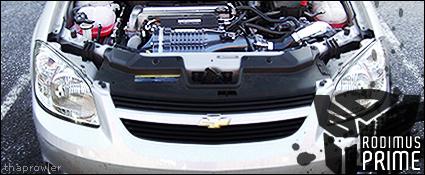my cat sound like crap and i was wondering if i could do away with it all together. will this give me problems and will it make the exhaust sound much different?

well anything you change in your exhaust will make it sound different. and in most if not all states its illegal to run without a cat. its probally best to get a high flow cat

Im a Xbox 360 fanboy...and damn proud of it!!
The cat is what generally makes your exhaust less poisonious (sp?) to the air. If thats removed, your car becomes illegal and impounded

it is a high flow cat. the reason i ask is because i have a horrible noise coming from there between 2500 and 3000 rpm while under load. do you really think a cop is going to look under my car for that?

No a cop might not however i bet the inspection station does when ya take your car for one. =)
if theres a noise, it can simply be a leak somwhere. easy fix.

unless your running a high amount of boost it would actually give you less power

1989 Turbo Trans Am #82, 2007 Cobalt SS G85
not fact, different cars do different things, not all N/A cars are going to lose power because the cat was removed...on our cars though...prob not ganna do anything.

actually its a fact on pretty much most cars on this site which are not up in the mods list, or nitrous, or boost, the cat serves to keep the exhaust gasses hot and flowing fast.
removal of the cat will cause exhaust gasses to cool faster, which stagnates flow or slows the flow down, causing you to actually lose power.

this can be applied to almost any near stock car with little mods.

Good explanation,
... therefore if you want to remove something to make your car go faster, start with something heavier like the pistons or crank

Dam-it Muffins (Event) wrote:actually its a fact on pretty much most cars on this site which are not up in the mods list, or nitrous, or boost, the cat serves to keep the exhaust gasses hot and flowing fast.
removal of the cat will cause exhaust gasses to cool faster, which stagnates flow or slows the flow down, causing you to actually lose power.

BlackEco wrote:Good explanation,
... therefore if you want to remove something to make your car go faster, start with something heavier like the pistons or crank 
Dam-it Muffins (Event) wrote:actually its a fact on pretty much most cars on this site which are not up in the mods list, or nitrous, or boost, the cat serves to keep the exhaust gasses hot and flowing fast.
removal of the cat will cause exhaust gasses to cool faster, which stagnates flow or slows the flow down, causing you to actually lose power.
not a bad idea if you mean aluminum pistons and billet lightened or stock lightened and knife edged crank

Dam-it Muffins (Event) wrote:BlackEco wrote:Good explanation,
... therefore if you want to remove something to make your car go faster, start with something heavier like the pistons or crank 
Dam-it Muffins (Event) wrote:actually its a fact on pretty much most cars on this site which are not up in the mods list, or nitrous, or boost, the cat serves to keep the exhaust gasses hot and flowing fast.
removal of the cat will cause exhaust gasses to cool faster, which stagnates flow or slows the flow down, causing you to actually lose power.
not a bad idea if you mean aluminum pistons and billet lightened or stock lightened and knife edged crank
lmfao yup you lose alot of power by freeing up exhaust. cats dont keep exhaust hot, they're there to help the enviroment. idiots that put 3" exhaust on a 2.2L thats n/a and have a cold air intake is what makes for cool exhaust gases and slower flow.
_______________________
** Flat Broke Racing Inc.**
my old neighbor took the cat off his geo metro cuz it sounded like shat, and got BETTER gas mileage. why is that?
"Youre lucky that 100 shot of nos didnt blow the welds on your intake"
-Vin Diesel
its definitely not an exhaust leak. thats originally what i thought it was, so i had a section where i figured it was leaking from welded with no change. its definitely the cat. the guy that did the weld for me said that it was the air moving through it creating that sound. it almost sounds like something is loose in there and starts to flap once it gets enough pressure behind it (2500rpm). or maybee it is an excess of fuel burning off in that specific rpm band. can anyone shed some factful light on this?

Cats don't keep the ehaust hotter they are just there to clean some of the crap your engine is putting out but they do cause back pressure which is why u get better gas mileage. And after the exhaust leaves the combustion chamber it has to cool not stay hot to flow better consider cooler temps means more dense gas that doesn't take up as much space. Only problem is ur engine needs back pressure for the computer to work properly
The ceramic type plates in a cat do keep your exhaust heated and collect moisture
(polutants).
There is no need for a slightly modified 4 cylinder vehicle to remove the cat.
The cat WILL NOT back-up or restrict the flow of your exhaust (unless running high compression rate, supercharged, Turbo, small cases Nitro, or a 8 cylinder)
But, if you still wish to get rid of your cat. hit it with a hammer a few times and shake out the crap, or drill out the inside.
05CavCoupe wrote:Cats don't keep the ehaust hotter they are just there to clean some of the crap your engine is putting out but they do cause back pressure which is why u get better gas mileage. And after the exhaust leaves the combustion chamber it has to cool not stay hot to flow better consider cooler temps means more dense gas that doesn't take up as much space. Only problem is ur engine needs back pressure for the computer to work properly
cats DO keep the exhaust gasses hot.
the catalyst has to become hot to burn off the hydrocarbons, nitric oxide, etc....
if you pass something over or through something thats hot, it will reheat it. thermal conductivity.
exhaust gasses start to cool as soon as they are released from the head into the manifold or header. this is the reason why header wrap insulates the pipe to keep em hot as possible and also why ceramic coating does the same, and also helps with velocity and exhaust gas scavenging.
the cat then is hot enough to burn off the excess bad stuff, but its another point through the exhaust line that keeps the gases hot. hence the reason most cats have a heated o2 sensor that is heated until the cat reaches temp to do it on its own

if the second o2 sensor isnt heated it will throw a code (or from malfunction of not having a functioning heated circuit) before the cat is fully heated.
and back pressure.... they dont cause much.
heres an article some of you should check out on back pressure:
http://www.magnaflow.com/05news/magazine/05sportc.asp
Quote:
BACKPRESSURE = TORQUE?
An old hot-rodder's tall tale: Engines need some backpressure to work properly and make torque. That is not true. What engines need is low backpressure, but high exhaust stream velocity. A fast-moving but free-flowing gas column in the exhaust helps create a rarefaction or a negative pressure wave behind the exhaust valve as it opens. This vacuum helps scavenge the cylinder of exhaust gas faster and more thoroughly with less pumping losses. An exhaust pipe that is too big in diameter has low backpressure but lower velocity. The low velocity reduces the effectiveness of this scavenging effect, which has the greatest impact on low-end torque.
Low backpressure and high exhaust stream velocity can be achieved by running straight-through free-flowing mufflers and small pipe diameters. The only two exceptions to this are turbocharged engines and engines optimized for large amounts of nitrous oxide. Both of these devices vastly increase the exhaust gas volume and simply need larger pipes to get rid of it all.Quote:

from that same link on the cat converters....
Quote:
TO CAT OR NOT TO CAT
Whatever you do, do not remove or gut out the catalytic converter on your street machine. The monolithic, straight-through design of modern three-way catalytic converters is usually quite free flowing on most modern imports, producing at the most, only a pound or two of extra backpressure. A gutted cat can actually hurt power as the empty box can cause flow stagnation, which effectively shortens the length of the moving gas column in the exhaust pipe. The empty box can also reduce important flow velocity. This can be felt as loss in bottom-end power.
Because of these factors, it is not unusual for cars to actually gain power with the addition of a cat.
also to back that up one really good book i can reccomend you all reading.
http://www.lingenfelter.com/store/bk-g309.html

g'luck

Its doesn't exactly have much time to cool from the 900-1000 degrees when it exits the head and then pretty much into the cat
because as I remember sitting in a muffler shop seeing a diagram showing the temps of the exhaust n funny thing was it showed that at the cat it was bout 100-200 degrees cooler then from the head now how could that be by what ur saying and funny thing was it was probably from magnaflow to boot
ummm.... i asked a follow up question a few posts back. anyone want to quit arguing for a moment and give me their opinion?

05CavCoupe wrote:Its doesn't exactly have much time to cool from the 900-1000 degrees when it exits the head and then pretty much into the cat
because as I remember sitting in a muffler shop seeing a diagram showing the temps of the exhaust n funny thing was it showed that at the cat it was bout 100-200 degrees cooler then from the head now how could that be by what ur saying and funny thing was it was probably from magnaflow to boot
it has a decent distance. once the exhuast exits, even on a ecotec, it starts to cool. your exhaust pipe acts like a giant heat sink.
stock pipes are NOT coated. and uncoated or un wrapped pipes loose heat way faster than the former.
basically the diagram prooves my point.
i;ve actually laser temped stock exhaust pipes.... usually in the 2-300 degree range.
so if the cat in your diagram was 1-200 degrees cooler than the head thats 700 degrees at the coolest. which would be the cat...
thats 300-400 degrees HOTTER than the normal exhaust gas, and especially when it exits.
and if you read the article it wasnt from magnaflow, it was from SCC.
the book i posted above has the same info.
if you check out how gases heat and cool, you will see that exhaust gasses cool very quickly once released from their source.
the catalyst once heated serves as a gate for gasses to pass through, and yes it keeps it heated...
on a turbo or nitrous, not as much a large deal as egts can be anywhere from 1000-1300+ and thats on the downstream pipe.
howeversimilar to how a cryo2 kit works for the intake.... the bulb in the cryo2 kit gets cold and cools down the air as it passes over it.
the catalyst keeps the exhaust gasses hot as they pass through it.
same concept, one incoming, one outgoing.

U need the cat plain and simple n if u looked at the link Dam-it Muffins posted says exactly what u need to know














